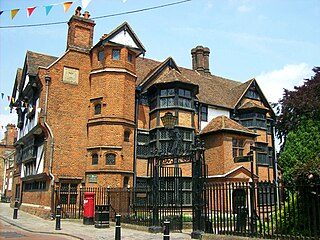
Sir Henry Wotton was an English author, diplomat and politician who sat in the House of Commons in 1614 and 1625. When on a mission to Augsburg in 1604, he famously said "An ambassador is an honest gentleman sent to lie abroad for the good of his country".
Anthony Irby was an English lawyer and politician who sat in the House of Commons at various times between 1589 and 1622.
Henry Stanhope, Lord Stanhope KB, known as Sir Henry Stanhope until 1628, was an English nobleman and politician.
Sir Edward Knatchbull, 4th Baronet was an English politician who sat in the House of Commons of England from 1702 to 1705 and in the House of Commons of Great Britain variously between 1713 and 1730.

Thomas Smythe or Smith of London, Ashford and Westenhanger, Kent was the collector of customs duties in London during the Tudor period, and a member of parliament for five English constituencies. His son and namesake, Sir Thomas Smythe, was the first governor of the East India Company, treasurer of the Virginia Company, and an active supporter of the Virginia colony.

Isaac Bargrave was an English royalist churchman, Dean of Canterbury from 1625 to 1643.
Sir Albertus Morton was an English diplomat and Secretary of State. His widow's death, apparently from grief, is commemorated in a celebrated epigraph by his relative Sir Henry Wotton.

Edward Wotton, 1st Baron Wotton (1548–1626) was an English diplomat and administrator. From 1612 to 1613, he served as a Lord of the Treasury. Wotton was Treasurer of the Household from 1616 to 1618, and also served as Lord Lieutenant of Kent from 1604 until 1620.

Sir Henry Guildford, KG (1489–1532) was an English courtier of the reign of King Henry VIII, master of the horse and comptroller of the royal household.
Sir Henry Lynch, 1st Baronet was an Irish baronet, knight, lawyer, and land agent. Lynch was among the first of his family to become a lawyer, and several of his younger sons followed him into this profession, as did, under his influence, Patrick D'Arcy, Richard Martyn, and Geoffrey Browne as well as many of the later generations of the Tribes of Galway.
Sir Francis Barnham (1576–1646) was an English politician who sat in the House of Commons at various times between 1604 and 1646. He supported the Parliamentary cause in the English Civil War.

Sir John Marsham, 1st Baronet was an English antiquary known as a writer on chronology. He was also a chancery clerk and politician who sat in the House of Commons from 1660 to 1661.
Sir John Garrard, sometimes spelled Gerrard, was a merchant and alderman of the City of London, six times Master of the Worshipful Company of Haberdashers, a Buckinghamshire landowner, and Lord Mayor of London for the year 1601 to 1602.

Sir Thomas Smythe was an English merchant, politician and colonial administrator. He was the first governor of the East India Company and treasurer of the Virginia Company from 1609 to 1620 until enveloped by scandal.
Sir William Ayloffe, 1st Baronet, of Braxted Magna in Essex, was knighted by James I in 1603, created a baronet in 1612 and sat as a Member of Parliament (M.P.) from 1621 to 1622.

Sir Charles Montagu of Cranbrook Hall in the parish of Barking, Essex, was an English politician who sat in the House of Commons from 1614 to 1625.
Sir Edward Wotton (1489–1551) was the Treasurer of Calais and a privy councillor to Edward VI of England.
Simon Lowe, alias Fyfield, was a rich English merchant tailor in the City of London, and also a landowner in several counties, briefly one of the members of the House of Commons of England representing two boroughs in other parts of England.

Eastgate House is a Grade I listed Elizabethan townhouse in Rochester, Kent, England. It is notable for its association with author Charles Dickens, featuring as Westgate in The Pickwick Papers and as the Nun's House in The Mystery of Edwin Drood. Now a Dickens Museum, the grounds of Eastgate House contain the Swiss chalet in which Dickens penned several of his novels.

Sir Robert Hampson (1537–1607) was one of the two Sheriffs of the City of London in 1599 with Edward Holmeden. He was an Alderman of the City of London and was knighted by King James I on his entry into England in 1603.









